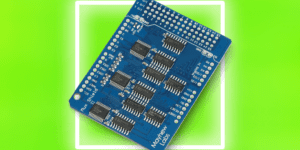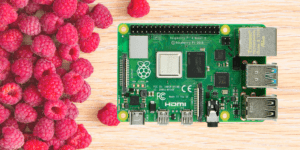Spis treści:
- 1 The invention of the first Intel 4004 microprocessor occurred 50 years ago. We could describe it as another event of equal importance to the invention of the transistor, which initiated a revolution in the world of electronics and computer science, but also in the other fields of science, technology and our everyday life too.
- 2 Arduino – good choice for beginners
- 3 Raspberry Pi – high computing power for advanced tasks
The invention of the first Intel 4004 microprocessor occurred 50 years ago. We could describe it as another event of equal importance to the invention of the transistor, which initiated a revolution in the world of electronics and computer science, but also in the other fields of science, technology and our everyday life too.
Today, microprocessors and microcontrollers can be found almost everywhere – in telephones, cameras, TVs, washing machines, refrigerators, cars, toys, power tools and many other devices. Then we are talking about embedded systems. What’s more, using the appropriate tools, you can manually program the microcontroller or microprocessor to perform control functions according to the designed embedded application. To build your own embedded projects, you just need to buy a single-board mini-computer – the most popular devices in this computers category are Raspberry Pi and Arduino.
Both platforms have many advantages, first being affordable price. There’s a wide user community, outstanding tech support and huge projects database. However we can point out a few differences between the two platforms and, when you pay attention to them, it will be easier for you to choose the right one for your projects’ requirements. Our quick tutorial shows the most essential technical aspects of the Arduino and Raspberry Pi boards.
Arduino – good choice for beginners
Arduino is usually associated with little blue-colored PCBs with Atmega microcontrollers, but this is only a basic hardware side of the Arduino ecosystem. Together it works with Arduino IDE software that contains the code editor. Both hardware and software components of Arduino are open-source-licensed. By this, all of the blueprints and technical datasheets are legally available for everyone with a permission for modifying factory hardware and software, and sharing it freely.

Arduino is beginners’ favourite choice in the world of electronics and programming. Arduino’s programming language is based on the simplified syntax of the C / C ++ language and such commands as setting logic states to I / O are easier to read compared to the commands in standard low level programming languages. On the hardware side, most Arduino Boards are based on AVR Atmega328 microcontrollers clocked at 16MHz.The programmable input and output system allows you to build projects such as automatically controlled LED lighting, servo motor controller or environmental measurements station.
Arduino is affordable and is a very good tool to start learning programming, and the open-source license allows you to produce your own board based on Arduino, which is particularly favorable for this platform in relation to the Raspberry Pi. On the drawbacks – due to the low computing power of the MCU, more demanding projects cannot be realized. In addition to Arduino boards, you can also purchase complete starter kits with sensors, solderless breadboards, wires, LEDs and other useful elements and also – Arduino Shield hardware extensions with ready-to-use software libraries and example codes.
Raspberry Pi – high computing power for advanced tasks
The labor market demand for specialists is constantly growing, and employers require the skills of programming embedded systems. For this reason, programming on universities is not only a part of computer science, but also other fields of studies, such as mechanical, electrical and civil engineering. For this purpose, appropriate teaching and learning tools are needed. The answer to this quest is the Raspberry Pi – a computer that fits in the palm of your hand, but it is very versatile and can perform most of the tasks we normally use with standard full-sized PCs. A fourth generation Raspberry Pi, known as the Raspberry Pi 4B, is currently in production. In addition to purely educational purposes, the Pi 4B can be used as a computer for hobbyists-tinkerers and professional electronics’ designers.

Most models of Raspberry Pi PCBs have quite similar dimensions to Arduino Uno. Here we have all of the necessary components used in a standard PCs: a CPU (which in most versions of Raspberry Pi is clocked at over 1GHz of frequency and together with GPU is an integral part of SoC), mass storage (instead of SSD or HDD, we got a micro SD memory card here), USB and HDMI connectors and Wi-Fi + Bluetooth for wireless communication, which is part of much pricey versions of the Arduino boards. Beside the hardware embedded applications, you can use Raspberry Pi as a regular desktop computer with standard peripheral devices such as mouse, keyboard, display and speakers. Dedicated Raspberry Pi OS operating system is installed and run from a micro SD card. Users can also install almost any Linux distribution and Windows 10 IoT.
Which one should you get?
When we compare Arduino and Raspberry Pi, we see the same significant advantage in both cases – affordable price and small dimensions. Significant differences can only be seen in the hardware and the Raspberry Pi definitely wins in this field. Parameters such as CPU clock frequency or RAM capacity, USB, Wi-Fi and Bluetooth connectivity makes this little fruit a really powerful tool and brings a great advantage if we want to use this as a general purpose desktop computer or controller for embedded devices with a high number of peripherals.


But hey! Maybe Arduino is not that powerful, but it’s still a very useful piece of hardware. Those little blue boards with AVR chips are great tools for rapid prototyping and it provides connectivity for devices such as sensors, motors, keypads, displays, PWM controllers for LEDs and motors and many more.
Hence, Arduino is widely used by professionals. They are easy to use and you don’t need to install the operating system. By using Arduino, you can learn the basics of coding and discover interaction between the hardware and software layers – before you eventually – not necessarily, of course – go with the Raspberry Pi.
Therefore, both platforms have numerous advantages, but when deciding to buy one of them, we must take into account our skills in using hardware and software and what requirements our purposes have to meet.
How useful was this post?
Click on a star to rate it!
Average rating 0 / 5. Vote count: 0
No votes so far! Be the first to rate this post.








